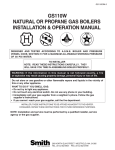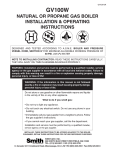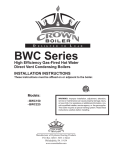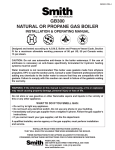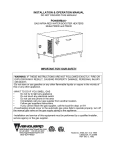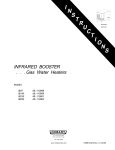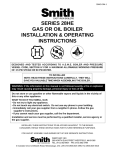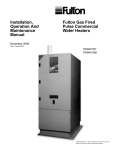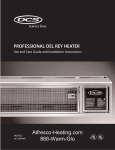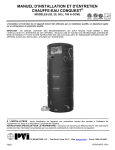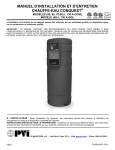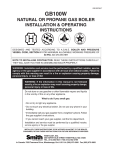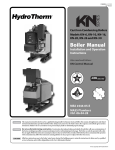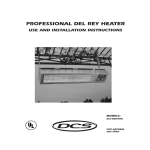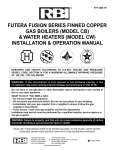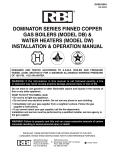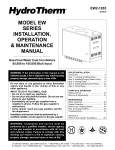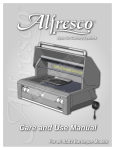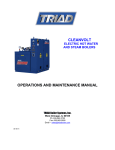Download MODEL FX SERIES INSTALLATION, OPERATION AND
Transcript
FXIOM-1 MODEL FX SERIES INSTALLATION, OPERATION AND MAINTENANCE MANUAL Direct Vent, Natural or Propane Gas-Fired Cast Iron Water Boilers 70,000 to 210,000 Btuh Input WARNING: If the information in this manual is not followed exactly, a fire or explosion may result causing property damage, personal injury or loss of life. Do not store or use gasoline or other flammable vapors and liquids in the vicinity of this or any other appliance. WHAT TO DO IF YOU SMELL GAS: • Do not try to light any appliance. • Do not touch any electrical switch. Do not use any phone in your building. • Immediately call your gas supplier from a neighbor’s phone. Follow the gas supplier’s instructions. • If you cannot reach your gas supplier, call the fire department. Installation and service must be performed by a qualified installer, service agency or the gas supplier. INSTALLER, THESE INSTRUCTIONS TO BE AFFIXED ADJACENT TO THE HEATER. CONSUMER, RETAIN THESE INSTRUCTIONS FOR FUTURE REFERENCE PURPOSES. IN UNITED STATES: 260 NORTH ELM ST. • WESTFIELD, MA 01085 • (413) 564-5515 • FAX (413) 568-9613 IN CANADA: 5211 CREEKBANK RD. • MISSISSAUGA, ONT. L4W 1R3 • (905) 625-2991 • FAX (905) 625-6610 www.hydrotherm.com Page 2 FX DIRECT VENT BOILER INSTALLATION AND OPERATION INSTRUCTIONS AVERTISSMENT. Assurez-vous de bien suivre les instructions données dans cette notice pour réduire au minimum le risque d’incendie ou d’explosion ou pour éviter tout dommoge matériel, toute blessure ou la mort Ne pas entreposer ni utiliser d’essence ou ni d’autres vapeurs ou liquides inflammables à proximité de cet appareil ou de tout autre appareil. QUE FAIRE SI VOUS SENTEZ UNE ODEUR DE GAZ: • Ne pas tenter d’allumer d’appareil. • Ne touchez à aucun interrupteur; ne pas vous servir des téléphones se trouvant dans le bâtiment. • Appelez immédiatement votre fournisseur de gas depuis un voisin. Suivez les intructions du fournisseur. • Si vous ne purvez rejoindre le fournisseur, appelez le service des incendies. L’installation et l’entretien doivent être assurés par un installateur ou un service d’entretien qualifié ou par le fournisseur de gaz. CONTENTS Before You Start ................................................. page 2 Boiler Ratings & Capacities ................................ page 3 Boiler Location ................................................... page 3 Clearances to Combustible Construction ........... page 3 Combustion Air & Ventilation .............................. page 4 Chimney & Vent Pipe Connections .................. page 10 Heating System Piping ..................................... page 15 Gas Supply Piping ............................................ page 18 Electrical Wiring ............................................... page 18 Lighting Instructions ......................................... page 22 Boiler Set Up .................................................... page 24 Boiler Operation ............................................... page 24 Checking & Adjusting ....................................... page 25 Boiler Maintenance .......................................... page 26 Replacement Parts ........................................... page 28 Instructions to the Installer ............................... page 31 Health Warnings ............................................... page 31 BEFORE YOU START WARNING: This manual must be read and fully understood before installing, operation or servicing this boiler! Failure to follow these instructions could result in a fire or explosion causing extensive property damage, personal injury or death! These instructions cover the FX gas fired, direct vent, low pressure, sectional, cast iron hot water boiler. FX boilers have been design certified by CSA for use with natural and propane gas under the latest edition of ANSI-Z21.13/CSA 4.9, Gas-Fired Low Pressure Steam and Hot Water Boilers. Each unit has been constructed and hydrostatically tested for a maximum working pressure of 30 psi in accordance with the ASME Boiler and Pressure Vessel Code, Section IV for cast iron boilers. Each boiler has been equipped with a 30 psi pressure relief valve. This manual covers the application, installation, operation and maintenance of a FX low pressure hot water boiler. To obtain the safe, dependable, efficient operation and long life for which this boiler was designed, these instructions must be read, understood and followed. Direct all questions to your Hydrotherm distributor or to the Customer Service Department, 260 North Elm Street, Westfield, MA 01085. Always include the model and serial numbers from the rating plate of the boiler in question. The owner should maintain a record of all service work performed with the date and a description of the work done. Include the name of the service organization for future reference. Where required by the authority having jurisdiction, the installation must conform to the Standard for Controls and Safety Devices for Automatically Fired Boilers, ANSI/ASME CSD-1. The installation must conform to the requirements of the authority having jurisdiction or, in the absence of such requirements, to the National Fuel Gas Code, ANSI Z223.1-latest revision. In Canada, the installation must be in accordance with the requirements of CSA B149.1 or B149.2 Installation Code for Gas Burning Appliances and Equipment. FX DIRECT VENT BOILER INSTALLATION AND OPERATION INSTRUCTIONS BOILER RATINGS & CAPACITIES Before undertaking the installation of the FX check the boiler rating plate to ensure that the boiler is the proper size for the job. The "Net I=B=R Ratings" specify the equivalent amount of direct cast iron radiation that the boiler can handle under normal conditions. Also ensure that the boiler has been set up for the type of gas available at the installation site. Other important considerations are the availability of an adequate electrical supply, fresh air for combustion and proximity a suitable outside wall. BOILER LOCATION WARNING: The clearances to combustible construction show in Figure 1 must be maintained. Failure to comply with this warning can result in extensive property damage, severe personal injury or death! CAUTION: Do not lift the boiler by the jacket. Use a hand truck under the base frame as shown in Figure 2. 1. Locate the boiler in an area that provides good access to the unit. Keep in mind that servicing may require the removal of jacket panels. Accessibility clearances must take precedence over fire protection clearances. 2. An optimum site will be level, central to the hot water piping system, close to an outside wall and have adequate fresh air for combustion. 3. Ensure that the floor is structurally sound and will support the weight of the boiler. Figure 1 - Clearances to Combustible Construction Page 3 NOTE: This boiler is designed for direct placement on a combustible floor. Never install this boiler on carpeting! 4. DO NOT install this boiler in a location that would subject any of the gas ignition components to direct contact with water or excessive moisture during operation or servicing. 5. NEVER store objects on or around the boiler. WARNING: Never store combustible materials, gasoline or any product containing flammable vapors or liquids in the vicinity of the boiler. Failure to comply with this warning can result in extensive property damage, severe personal injury or death! Figure 2 - Moving Boiler Page 4 FX DIRECT VENT BOILER INSTALLATION AND OPERATION INSTRUCTIONS COMBUSTION AIR & VENTILATION WARNING: This boiler must be supplied with combustion air in accordance with Section 5.3, Air for Combustion & Ventilation, of the latest revision of the National Fuel Gas Code, ANSI Z223.1/NFPA 54 and all applicable local building codes. Canadian installations must comply with CSA B149.1 or .2 Installation Code for Gas Burning Appliances and Equipment, or applicable provisions of the local building codes. Failure to provide adequate combustion air for this boiler/water heater can result in excessive levels of carbon monoxide which can result in severe personal injury or death! To operate properly and safely this boiler requires a continuous supply of air for combustion. NEVER store objects on or around the boiler! CAUTION: Combustion air contaminated with fluorocarbons or other halogenated compounds such as cleaning solvents and refrigerants will result in the formation of acids in the combustion chamber. These acids will cause premature failure of the boiler voiding the warranty! CAUTION: If the boiler is operated while the building is under construction it MUST be protected from wood, concrete, sheet rock and other types of dust. Failure to properly protect the unit from construction dust will damage the unit voiding the warranty! Buildings may require the installation of a fresh air duct or other means of providing make-up air if the intake air option isn't used. Any building utilizing other gas burning appliances, a fireplace, wood stove or any type of exhaust fan must be checked for adequate combustion air when all of these devices are in operation at one time. Sizing of an outside air duct must be done to meet the requirements of all such devices. WARNING: Never operate this boiler in an environment subjected to a negative pressure unless the air intake is connected to the outdoors. Failure to comply with this warning can result in excessive levels of carbon monoxide causing severe personal injury or death! All Combustion Air From Inside The Building Older houses often have enough “leakage” to provide an adequate amount of combustion air provided that the demand for combustion air is not too great, Figure 3. Homes that are relatively new or “tight” will most likely require that the combustion be ducted to the boiler from outside the building. Any home utilizing other gas burning appliances, a fireplace, wood stove or any type of exhaust fan must be checked for adequate combustion air when all of these devices are in operation at one time. If the boiler is to be located in an alcove, closet or other confined space the distances from the boiler and it's vent system to all-combustible construction must be equal to or greater than the minimum clearances in Figure 1. When installed in a closet or confined space two permanent openings of equal area adjoining another room or rooms having sufficient volume to meet the requirements of an unconfined space must be provided, Figures 4 & 5. Each opening must have a minimum free area of one square inch per 1000 Btu/hr (2200 mm2/ kW) based on the total input rating of all gas utilization equipment in the confined area. Each opening must be no less than 100 square inches 64516 mm2) in size. The upper opening must be within 12 inches (305 mm) of, but not less than 3 inches (76 mm) from, the top of the enclosure. The bottom opening must be within 12 inches (305 mm) of, but not less than 3 inches (76 mm) from, the bottom of the enclosure. All Combustion Air From Outside The Building When installed in a confined space without the intake air option two permanent openings communicating directly with, or by ducts to, the outdoors or spaces that freely communicate with the outdoors must be present. The upper opening must be within 12 inches (305 mm) of, but not less than 3 inches (76 mm) from, the top of the enclosure. The bottom opening must be within 12 inches 305 mm) of, but not less than 3 inches (76 mm) from, the bottom of the enclosure. Where directly communicating with the outdoors or communicating with the outdoors through vertical ducts, each opening shall have a minimum free area of 1 in2/ 4000 Btu/hr (550 mm2/kW) of the total input rating of all of the equipment in the enclosure. Where communicating with the outdoors through horizontal ducts, each opening shall have a minimum free area of 1 in2/2000 Btu/hr (1100 mm2/kW) of the total input rating of all of the equipment in the enclosure. When ducts are used, they must have the same crosssectional area as the free area of the opening to which they connect. Sizing of an outside air duct must be based on the total input rating of all gas utilization equipment in the confined space. FX DIRECT VENT BOILER INSTALLATION AND OPERATION INSTRUCTIONS When calculating the free area necessary to meet the make-up air requirements of the enclosure, consideration must be given to the blockage effects of louvers, grills and screens. Screens must have a minimum mesh size of 1/4" (6.4mm). If the free area through a louver or grill is not known ducts should be sized per Table 1. Page 5 Table 1 - Combustion Air Duct Sizing FreshAir Duct Size Input Btuh 1/4” Wire Screen Mesh Input Btuh Metal Louvers Input Btuh Wooden Louvers 3” x 12” 8” x 8” 8” x 12” 8-1/2” x 16” 144,000 256,000 384,000 512,000 108,000 192,000 288,000 384,000 36,000 64,000 96,000 128,000 Figure 3 - Horizontal Positive Pressure Venting Using Inside Combustion Air Figure 4 - Vertical Negative Pressure Masonry Chimney System Using Inside Combustion Air Page 6 FX DIRECT VENT BOILER INSTALLATION AND OPERATION INSTRUCTIONS Figure 5 - Vertical Negative Pressure Metal Chimney System and Inside Combustion Air Intake Air Option - General Guidelines This configuration provides combustion air directly to the boiler using a dedicated pipe. Combustion air can be drawn in horizontally through an outside wall or vertically through the roof, see Figures 6, 7, 8, 9 & 10. WARNING: Each boiler must have it's own intake air system. Common intake air systems are not to be used! Improper installation can result in excessive levels of carbon monoxide which can cause severe personal injury or death! Single wall galvanized smoke pipe, single wall aluminum pipe, flexible aluminum pipe, PVC or CPVC pipe can be used for the intake air pipe. It must be sized per Table 2. Table 2 - Combustion Air System Sizing Boiler Model Number FX-3 FX-4 FX-5 FX-6 FX-7 Equivalent Intake Length (see note) 3” Diameter Equivalent Intake Length (see note) 4” Diameter 45 feet (13.7 m) 45 feet (13.7 m) 45 feet (13.7 m) n/a n/a 65 feet (19.8 m) 65 feet (19.8 m) 65 feet (19.8 m) 40 feet (12.2 m) 40 feet (12.2 m) Note: Subtract 5 feet (1.5 m) for each 90° elbow. FX DIRECT VENT BOILER INSTALLATION AND OPERATION INSTRUCTIONS All joints in metal intake air systems must be secured using corrosion resistant fasteners and sealed using a suitable Silicone caulk. If PVC or CPVC is used, the joints must be cleaned with a suitable solvent and connected using a solvent based PVC cement. The intake air system MUST be supported by the building structure not the boiler/water heater. Intake Air Option - Vertical Guidelines A listed, nonrestrictive intake air cap must be used. The intake air cap must terminate as shown in Figure 6. The penetration point in the roof must be properly flashed and sealed. Page 7 Intake Air Optional - Horizontal Guidelines The maximum equivalent length for the horizontal intake air pipe is listed in Table 3. The intake air system must be pitched down, toward the terminal, 1/4" per foot (21 mm per meter). If horizontal runs exceed 5 feet (1.5 m) they must be supported at 3 foot (0.98 m) intervals with overhead hangers. Figures 6 through 9 show the four horizontal air intake options. The intake terminations certified for use the FX are listed in Table 5. Figure 6 - Vertical Positive Pressure Venting with Outdoor Combustion Air Page 8 FX DIRECT VENT BOILER INSTALLATION AND OPERATION INSTRUCTIONS Figure 7 - Horizontal Positive Pressure Venting with Outdoor Combustion Air Figure 8 - Horizontal Positive Pressure Concentric Venting with Outdoor Combustion FX DIRECT VENT BOILER INSTALLATION AND OPERATION INSTRUCTIONS Figure 9 - Vertical Negative Pressure Masonry Chimney System using Outside Combustion Air Figure 10 - Vertical Positive Pressure Venting using Outside Combustion Air Page 9 Page 10 FX DIRECT VENT BOILER INSTALLATION AND OPERATION INSTRUCTIONS GENERAL VENTING GUIDELINES WARNING: The vent installation must be in accordance with Part 7, Venting of Equipment, of the National Fuel Gas Code, ANSI Z223.1/ NFPA 54-latest revision or applicable provisions of the local building codes. Canadian installations must comply with CSA B149.1 or .2 Installation Code. Improper venting can result in excessive levels of carbon monoxide which can result in severe personal injury or death! WARNING: Thimbles and fire-stops must be used where required. A minimum clearance of 6" must be maintained between single wall metal vents and combustible construction or a fire resulting in severe personal injury or death may occur! WARNING : Each boiler/water heater must have it's own vent system. Common positive pressure vent systems are not to be used! Improper installation can result in excessive levels of carbon monoxide which can cause severe personal injury or death! All vent systems must be fully supported by the building structure and not by the boiler/water heater. VENT SYSTEM OPTIONS The FX may be vented the following ways: 1) Direct Vent (Positive Pressure), uses a vent system certified to UL 1738 for installations in the United States, ULS636 for installations in Canada. Combustion air is piped from the outdoors to the blower inlet. 2) Horizontal Vent (Positive Pressure), uses a vent system certified to UL 1738 for installations in the United States, ULS636 for installations in Canada. Combustion air is obtained from the space in which the unit is installed. 3) Vertical Vent (Positive Pressure), uses a vent system certified to UL 1738 for installations in the United States, ULS636 for installations in Canada. Combustion air is piped from the outdoors to the blower inlet or is obtained from the space in which the unit is installed. 4) Vertical/Chimney Vent (Negative Pressure), uses an approved metal chimney system or masonry chimney. Combustion air is obtained from the space in which the unit is installed or is piped from the outdoors to the blower inlet. GENERAL DIRECT VENT INFO In this configuration the boiler blower is used to push the flue products to the outdoors while drawing combustion air from the outdoors. The instructions under the COMBUSTION AIR & VENTILATION SECTION must be followed! The vent system must be sized per Table 3. Table 3 - Positive Pressure Vent System Sizing Boiler Model Number Equivalent Intake Length (see note) 3” Diameter Equivalent Intake Length (see note) 4” Diameter FX-3 FX-4 FX-5 FX-6 FX-7 45 feet (13.7 m) 45 feet (13.7 m) 45 feet (13.7 m) n/a n/a 65 feet (19.8 m) 65 feet (19.8 m) 65 feet (19.8 m) 40 feet (12.2 m) 40 feet (12.2 m) Note: Subtract 5 feet (1.5 m) for each 90° elbow. HORIZONTAL DIRECT VENT SYSTEMS See figures 7 & 8. The vent materials used in horizontal positive pressure vent systems must be certified to UL 1738 for installations in the United States, ULS636 for installations in Canada. Certified vent systems are manufactured by the following companies: Heat-Fab, Inc. 130 Industrial Blvd., Turners Falls, MA 01376 (800) 772-0739. Z-Flex U.S., Inc. 20 Commerce Park North, Bedford, NH 03110-6911 (800) 654-5600. Protech Systems Inc. 26 Gansevoort Street, Albany, NY 12202 (518) 463-7284 The maximum equivalent length for the horizontal vent system is listed in Table 4. Each 90° elbow is equal to 5 linear feet (1.5 m) of pipe. To maximize the performance of single wall sheet metal vent systems locate 90° elbows as far from the boiler as possible and from one another. For best results, horizontal vent systems should be as short and straight as possible. The vent system must be both gas tight and watertight. All seams and joints in metal pipes must be joined and sealed in accordance with the vent system manufacturer’s instructions. When horizontal vent runs exceed 5 feet (1.5m) they must be supported at 3 foot (0.98 m) intervals with overhead hangers. The vent system must be pitched down, toward the vent terminal, 1/4" per foot (21mm per meter). If any part of a single wall metal vent system passes through an unheated space it must be insulated with insulation rated for 400°F. Structural penetrations must be made using approved thimbles. FX DIRECT VENT BOILER INSTALLATION AND OPERATION INSTRUCTIONS Horizontal vent systems shall terminate at least 4 feet (1.3 m) below, 4 feet (1.3 m) horizontally from or 1 foot (0.23 m) above any door, window or gravity air inlet into any building. It must not terminate less than 4 feet (1.3 m) horizontally from, and in no case above or below, unless a 4 feet (1.3 m) horizontal distance is maintained, from electric meters, gas meters, regulators and relief equipment and not less than 7 feet (2.3 m) from any adjacent public walkway. The bottom of the vent terminal(s) shall be located at least 5 feet (1.5 m) above the air intake terminal(s). Avoid terminal locations likely to be affected by winds, snowdrifts, people and pets. The certified vent terminals listed in Table 4 must be used. Protect building materials and vegetation from degradation caused by the flue gases. Page 11 The maximum length for the vertical vent system is listed in Table 4. Each 90° elbow is equal to 5 linear feet (1.5 m) of pipe. To maximize the performance of single wall sheet metal vent systems locate 90° elbows as far from the boiler as possible and from one another. If any part of a single wall metal vent system passes through an unheated space it must be insulated with insulation rated for 400°F. Structural penetrations must be made using approved fire-stops. The vent system must be both gas tight and watertight. All seams and joints in metal pipes must be joined and sealed in accordance with the vent system manufacturer’s instructions. Vertical vent systems must be terminated with an approved terminal cap as shown in Figures 6 & 10. Table 4 - Certified Vent & Intake Terminals Company Protech Protech Protech Protech Protech Protech Protech Protech Field Controls Heat-Fab Heat-Fab Heat-Fab Heat-Fab Heat-Fab Heat-Fab Heat-Fab Heat-Fab Part No. 300311 300312 300186 300187 300130 300131 300160 300161 SWH-4” CAT-4HG 7390GC 7490GC 7390TEE 7490TEE 7392GC 7492GC 7314TERM 7414TERM Description Tee Tee Bird Screen Bird Screen 45° Elbow 45° Elbow 90° Elbow 90° Elbow Vent Hood Air Tee Mitered Mitered Tee Tee Screen Screen 90° Elbow 90° Elbow Dia. (in.) 3 4 3 4 3 4 3 4 4 4 3 4 3 4 3 4 VERTICAL DIRECT VENT SYSTEMS See Figures 6 & 10. The vent materials used in vertical positive pressure vent systems must be certified to UL 1738 for installations in the United States, ULS636 for installations in Canada. Certified vent systems are manufactured by the following companies: Heat-Fab, Inc. 130 Industrial Blvd., Turners Falls, MA 01376 (800) 772-0739. Z-Flex U.S., Inc. 20 Commerce Park North, Bedford, NH 03110-6911 (800) 654-5600. Protech Systems Inc. 26 Gansevoort Street, Albany, NY 12202 (518) 463-7284 HORIZONTAL VENT POSITIVE PRESSURE SYSTEMS See Figure 3. The vent materials used in horizontal positive pressure vent systems must be certified to UL 1738 for installations in the United States, ULS636 for installations in Canada. Certified vent systems are manufactured by the following companies: Heat-Fab, Inc. 130 Industrial Blvd., Turners Falls, MA 01376 (800) 772-0739. Z-Flex U.S., Inc. 20 Commerce Park North, Bedford, NH 03110-6911 (800) 654-5600. Protech Systems Inc. 26 Gansevoort Street, Albany, NY 12202 (518) 463-7284 The maximum equivalent length for the horizontal vent system is listed in Table 4. Each 90° elbow is equal to 5 linear feet (1.5 m) of pipe. To maximize the performance of single wall sheet metal vent systems locate 90° elbows as far from the boiler as possible and from one another. Horizontal vent systems should be as short and straight as possible. When horizontal vent runs exceed 5 feet (1.5 m) they must be supported at 3 foot (0.98 m) intervals with overhead hangers. The vent system must be pitched down, toward the vent terminal, 1/4" per foot (21 mm per meter). If any part of a single wall metal vent system passes through an unheated space it must be insulated with insulation rated for 400°F. Structural penetrations must be made using approved thimbles. The vent system must be both gas tight and watertight. All seams and joints in metal pipes must be joined and sealed in accordance with the vent system manufacturer's instructions. Page 12 FX DIRECT VENT BOILER INSTALLATION AND OPERATION INSTRUCTIONS Horizontal vent systems shall terminate at least 4 feet (1.3 m) below, 4 feet (1.3 m) horizontally from or 1 foot (0.23 m) above any door, window or gravity air inlet into any building. It must not terminate less than 4 feet (1.3 m) horizontally from, and in no case above or below, unless a 4 feet (1.3 m) horizontal distance is maintained, from electric meters, gas meters, regulators and relief equipment and not less than 7 feet (2.3 m) from any adjacent public walkway. The bottom of the vent terminal(s) shall be located at least 5 feet (1.5 m) above the air intake terminal(s). Avoid terminal locations likely to be affected by winds, snowdrifts, people and pets. Table 5 - Certified Vent Terminals Company Protech Protech Protech Protech Protech Protech Field Field Heat-Fab Heat-Fab Heat-Fab Heat-Fab Part No. 300311 300312 300130 300131 300160 300161 SWH-3’’ SWH-4’’ 7390TEE 7490TEE 7314TERM 7414TERM Description Tee Tee 45° Elbow 45° Elbow 90° Elbow 90° Elbow Vent Hood Vent Hood Tee Tee 90° Elbow 90° Elbow Dia. (in.) 3 4 3 4 3 4 3 4 3 4 3 4 The certified vent terminals listed in Table 5 must be used. Protect building materials and vegetation from degradation caused by the flue gases. VERTICAL VENT POSITIVE PRESSURE SYSTEMS See Figure 11. The vent materials used in vertical positive pressure vent systems must be certified to UL 1738 for installations in the United States, ULS636 for installations in Canada. Certified vent systems are manufactured by the following companies: Heat-Fab, Inc. 130 Industrial Blvd., Turners Falls, MA 01376 (800) 772-0739. Z-Flex U.S., Inc. 20 Commerce Park North, Bedford, NH 03110-6911, (800) 654-5600. Protech Systems Inc. 26 Gansevoort Street, Albany, NY 12202 (518) 463-7284 The maximum length for the vertical vent system is listed in Table 4. Each 90° elbow is equal to 5 linear feet (1.5 m) of pipe. To maximize the performance of single wall sheet metal vent systems locate 90° elbows as far from the boiler as possible and from one another. If any part of a single wall metal vent system passes through an unheated space it must be insulated with insulation rated for 400 °F. Structural penetrations must be made using approved fire-stops. The vent system must be both gas-tight and watertight. All seams and joints in metal pipes must be joined and sealed in accordance with the vent system manufacturer's instructions. Vertical vent systems must terminate as shown in Figures 6 & 11. An approved terminal cap must be used. VERTICAL VENT NEGATIVE PRESSURE SYSTEMS See Figures 4, 5 & 9. The FX is listed as a Category I appliance when vented vertically into a metal chimney system or masonry chimney sized as listed in Table 7. WARNING: If an appliance using any type of a mechanical draft system operating under positive pressure is connected to a chimney flue, never connect any other appliances to this flue. Doing so can result in excessive levels of carbon monoxide which can cause severe personal injury or death! Chimney Inspection & Sizing A thorough inspection of the masonry chimney must be performed to ensure that the chimney is clean, properly constructed and properly sized. Exterior masonry chimneys should not be used unless properly lined to prevent condensation and draft problems. Table 4 lists the equivalent breeching and flue sizes required for the boiler/water heater. When more than one appliance is connected to the same chimney flue the flue must be large enough to safely vent the combined output of all of the appliances. Table 6 - Vent, Intake & Equivalent Chimney Size Boiler Model FX-70 FX-105 FX-140 FX-175 FX-210 Vent & Chimney Diameter inches (mm) 3 (7.6) 4 (10.2) 4 (10.2) 5 (12.7) 5 (12.7) Intake Diameter inches (mm) 3 (7.6) 3 (7.6) 3 (7.6) 4 (10.2) 4 (10.2) Note: These sizes are based on a 20 foot (6.1m) chimney height. FX DIRECT VENT BOILER INSTALLATION AND OPERATION INSTRUCTIONS The vent connector should be sloped up toward the chimney 1/4" per foot. Ensure that the vent connector is properly supported and each connection securely fastened with at least 3 corrosion resistant sheet metal screws. The termination of the vent pipe must be flush with the inside of the chimney flue. CAUTION: The vent connector length must never exceed 3/4 of the height of the chimney or venting problems will occur! Figure 11 - Vertical Positive Pressure Venting Page 13 Always provide a minimum clearance of 6 inches between single wall metal vent pipe and any combustible materials. Type B1 vent may be used, clearance between it and any combustible material must be as listed. WARNING: Failure to maintain minimum clearances between vent connectors and combustible materials can result in a fire causing extensive property damage, severe personal injury or death! Page 14 FX DIRECT VENT BOILER INSTALLATION AND OPERATION INSTRUCTIONS COMMON VENT SYSTEMS Dans la mesure du possible, fermer toutes les portes et les fenêtres du bâtiment et toutes les portes entre l'espace où les appareils toujours raccordés du système d'évacuation sont installés et les autres espaces du bâtiment. Mettre en marche les sécheuses, tous les appareils non raccordés au système d'évacuation commun et tous les ventilateurs d'extraction comme les hottes de cuisinère et les ventilateurs des salles de bain. S'assurer que ces ventilateurs fonctionnent à la vitesse maximale. Ne pas faire fonctionner les ventilateurs d'été. Fermer les registres des cheminées. WARNING: DO NOT connect this boiler or any other appliance using a positive pressure common vent system or a mechanical draft system! Failure to comply with this WARNING could result in the accumulation of carbon monoxide gas which can cause severe personal injury or death! If an existing boiler/water heater is removed from a common venting system, the common venting system may then be too large for the proper venting of the remaining appliances connected to it. At the time of removal of an existing boiler/water heater, the following steps shall be followed with each appliance remaining connected to the common venting system placed in operation, while the other appliances remaining connected to the common venting system are not in operation. Au moment du retrait d'une chaudière existante, les mesures suivantes doivent être prises pour chaque appareil toujours raccordé au système d'évacuation commun et qui fonctionne alors que d'autres appareils toujours raccordés au système d'évacuation ne fonctionnent pas: système d'évacuation d) Place in operation the appliance being inspected. Follow the lighting instructions. Adjust thermostat so appliance will operate continuously. Mettre l'appareil inspecté en marche. Suivre les instructions d'allumage. Régler le thermostat de façon que l'appareil fonctionne de façon continue. e) Test for spillage at the draft hood relief opening after 5 minutes of main burner operation. Use the flame of a match or candle, or smoke from a cigarette, cigar or pipe. Faire fonctionner le brûleur principal pendant 5 min ensuite, déterminer si le coupe-tirage déborde à l'ouverture de décharge. Utiliser la flamme d'une allunette ou d'une chandelle ou la fumée d'une cigarette, d'un cigare ou d'une pipe. a) Seal any unused openings in the common venting system. Sceller toutes les ouvertures non utilisées du système d'évacuation. b) Visually inspect the venting system for proper size and horizontal pitch and determine there is no blockage or restriction, leakage, corrosion and other deficiencies which could cause an unsafe condition. Inspecter de façon visuelle le système d'évacu-ation pour déterminer la grosser et l'inclinaison horizontale qui conviennent et s'assurer que le système est exempt d'obstruction, d'étranglement de fruite, de corrosion et autres défaillances qui pourraient présenter des risques. c) Insofar as is practical, close all building doors and windows and all doors between the space in which the appliances remaining connected to the common venting system are located and other spaces of the building. Turn on clothes dryers and any appliance not connected to the common venting system. Turn on any exhaust fans, such as range hoods and bathroom exhaust, so they will operate at maximum speed. Do not operate a summer exhaust fan for a boiler installation. Close fireplace dampers. f) After it has been determined that each appliance remaining connected to the common venting system properly vents when tested as outlined above, return doors, windows, exhaust fans, fireplace dampers and any other gas-burning appliance to their previous condition of use. Une fois qu'il a été d éterminé, selon la métode indiquée ci-dessus, que chaque appareil raccordé au système d'évacuation est mis à l'air libre de façor adéquate. Remettre les portes et les fenêtres, les ventilateurs, les registres de cheminées et les appareils au gaz à leur position originale. g) Any improper operation of the common venting system should be corrected so the installation conforms with the National Fuel Gas Code, ANSI Z223.1/NFPA 54. When resizing any portion of the common venting system, the common venting system should be resized to approach the minimum size as determined using the appropriate tables in Appendix F in the National Fuel Gas Code, ANSI Z223.1/ NFPA 54 and or CSA B149 Installation Codes. FX DIRECT VENT BOILER INSTALLATION AND OPERATION INSTRUCTIONS Tout mauvais fonctionnement du systéme d'évacution commun devrait étré corrigé de façor que l'installation soit conforme au National Fue Gas Code, ANSI Z223.1/NFPA 54 et (ou) aux codes d'installation CSA-B149. Si la grosseur d'une section du système d' évacuation doit étré modifiée, le système devrait étré modifié pour respecter les valeurs minimales des tableaux pertinents de l'appendice F du National Fuel Gas Code, ANSI Z223.1/ NFPA 54 et (ou) des codes d'installation CSA-B149. CONDENSATE PIPING A small amount of condensate is generated on start up. To prevent an excess amount of condensate collecting in the flue collector a condensate drain has been provided. A condensate trap or pump MUST be connected to the condensate fitting in the bottom of the flue collector. A trap can be made by tie wrapping a 4” loop in a piece of vinyl hose attached to the condensate drain fitting. The trap must be filled with water to prevent flue gasses from escaping, see Figure 12. Page 15 HEATING SYSTEM PIPING CAUTION: All heating system piping must be installed in accordance with the ANSI/ASME Boiler and Pressure Vessel Code, Section IV. All applicable local codes and ordinances must also be followed. If the boiler is installed above any radiation elements it must be fitted with a low water cutoff device installed above the normal boiler water level! The FX hot water boiler comes from the factory ready to be piped to the heating system. Each boiler is equipped with a safety relief valve which must be piped in accordance with the ANSI/ASME Boiler and Pressure Vessel Code, Section IV, see Figure 13. Table 7 - Boiler Water Volume Boiler Model FX-3 FX-4 FX-5 FX-6 FX-7 Water Volume Gallons 1.8 2.4 3.0 3.6 4.2 Liters 6.8 9.1 11.4 13.6 15.9 Figure 12 - Condensate Trap Figure 13 - Relief Valve Piping WARNING: Failure to connect a condensate trap or pump to the flue collector can result in excessive levels of carbon monoxide which can cause severe personal injury or death! Ensure that the boiler is level from front to back and from side to side. Use metal shims to level the boiler. NEVER use combustible materials for shims. Page 16 FX DIRECT VENT BOILER INSTALLATION AND OPERATION INSTRUCTIONS Bypass Piping CAUTION: Never connect this boiler directly to a large volume system, in-floor radiant system, snow melt system or any other system that would cause the steady state water temperature in the boiler to drop below 140°F. To prevent damage due to excessive condensation, one of the following piping options must be used or the boiler warranty will be voided! Pump Away Bypass The system bypass shown in Figure 15 should be used on single zone systems, or multiple zone systems using zone valves, when the circulator is installed in the supply piping. The bypass must be installed between the supply and return pipes on the pressure side of the circulator. Figure 15 - Pump Away Bypass Piping CAUTION: The blend pump arrangement shown in Figure 16 must be used when flow from any zone in a multiple zone system is less than 4 GPM or boiler short cycling on the high limit will occur! For the three systems listed below, adjust the bypass valve to divert some of the heated water back into the boiler's return piping. When adjusted correctly the temperature of the boiler water will exceed 140°F within five minutes of a warm start. A plug valve should be used as the bypass valve for best system performance. NOTE: Some of the circulator's capacity will be used in the blending process for the first two systems. Large heating systems may require a larger circulator. System Bypass The system bypass shown in Figure 14 should be used on single zone systems, or multiple zone systems using zone valves, when the circulator is installed in the return piping. The bypass must be installed between the supply and return pipes on the suction side of the circulator. Pumped Blend Bypass The system bypass shown in Figure 16 should be used on multiple zone systems. The bypass must be installed between the supply and return pipes on the suction side of the zone circulators. The bypass valve must be installed on the pressure side of the bypass circulator. Figure 14 - System Bypass Piping Figure 16 - Pumped Bypass Piping FX DIRECT VENT BOILER INSTALLATION AND OPERATION INSTRUCTIONS Piping For Use With Cooling Units The boiler, when used in connection with a refrigeration system must be installed so the chilled medium is piped in parallel with the boiler. Appropriate valves must be used to prevent the chilled water from entering the boiler. See Figure 17 for the proper piping layout. Figure 17 - Chiller Schematic NOTE FOR HEATING: VALVES "H" OPEN, VALVES "C" CLOSED. FOR COOLING: VALVES "H" CLOSED, VALVES "C" OPEN. Page 17 Circulators The TACO 007 circulator supplied with the boiler is sized for use in a closed heating system with a 30 psi maximum operating pressure. If the 007 circulator does not have the required capacity for the system in which it is to be installed, an extra zone circulator or a higher capacity circulator will be needed. Figure 18 depicts the performance curve for the TACO 007 circulator. Figure 18 - TACO 007 Performance Curve 10 EXP. TANK ROOM UNIT 8 H RELIEF VALVE C PUMP DRAIN FILL VALVE H HEAD - FEET OF WATER VENT 6 4 TACO 007 CIRCULATOR PERFORMANCE CURVE 2 C DRAIN BOILER CHILLER 0 When a boiler is connected to a heating coil that may be exposed to refrigerated air from an air handling device, the piping system must be equipped with flow-control valves or some other automatic means of preventing gravity circulation of the boiler water during the cooling cycle. 0 5 10 15 FLOW - GPM 20 25 Page 18 FX DIRECT VENT BOILER INSTALLATION AND OPERATION INSTRUCTIONS GAS SUPPLY PIPING Table 8 - Gas Pipe Capacity The FX hot water boiler comes from the factory ready to be piped to the gas supply. The gas supply can be piped from the left or right side of the boiler. Pipe length in feet 30 40 50 60 80 100 150 Gas pipe Capacity (ft3/hr) 3 278 190 152 130 115 105 90 79 64 /4″ 520 350 285 245 215 195 170 150 120 1″ 1050 730 590 500 440 400 350 305 250 11/4″ 1600 1100 890 760 670 610 530 460 380 11/2″ Note: Maximum pipe capacity in ft3/hr is based on a 0.60 specific gravity gas at a pressure of 0.5 psig and a 0.3" WC pressure drop. If for any reason the boiler is not for the type of gas available at the installation site, call the nearest Hydrotherm distributor to resolve the problem. Figure 19 depicts the proper way to connect the boiler to the gas supply piping. The manual shut-off valve MUST be installed in the supply piping. It should be approximately 5 feet above the floor. Provide a sediment trap/drip leg at the bottom of the vertical section of the gas supply pipe. A ground joint union should be installed between the boiler gas controls and the supply piping. Each of these items is needed to ensure long life and ease of servicing. Always use a pipe sealant that is suitable for use with LP gas. Figure 19 - Gas Supply Piping Nominal Iron Pipe Size, (in) 10 20 Table 9 - Equivalent Pipe Length Chart Nominal Iron Pipe Size, (in) /4″ 1″ 11/4″ 11/2″ 3 Type of pipe fitting Tee Gas Valve 90° Elbow Gas Cock (branch flow) (full port) Equivalent length of pipe fitting in feet 2.6 5.2 0.6 1.5 3.5 6.9 0.8 1.9 4.0 8.0 0.9 2.3 5.2 10.3 1.2 3.0 Whenever the gas supply piping is pressure tested the boiler gas controls must be protected. If the test pressure is equal to, or less than 1/2 psig (3.5 kPa) isolate the boiler by closing it's manual shut off valve, see Figure 8. If the test pressure is greater than 1/2 psig (3.5 kPa), disconnect the boiler and it's individual shut-off valve from the gas supply piping. WARNING: Never use an open flame to test for gas leaks. Always use an approved leak detection method. Failure to comply with this WARNING could result in an explosion! ELECTRICAL WIRING CAUTION: Label all wires prior to disconnection when servicing controls. Wiring errors can cause improper and dangerous operation! CAUTION: Always use a wrench on the gas valve body when making gas connections to it. Never over-tighten the piping entering the gas valve body or the gas valve will be damaged! Table 8 should be used to ensure that the gas supply piping is sized properly. If more than one appliance is supplied by the same supply pipe, the piping must be sized based on the maximum possible demand. Do not neglect the pressure drop due to pipe fittings. Table 9 should be used in conjunction with Table 8 to ensure that the gas supply piping is sized properly. Safe lighting and other performance criteria were met with the gas manifold and control assembly provided on the boiler when the boiler underwent tests specified in ANSI Z21.13. All gas connections MUST be leak tested before putting the boiler into operation. ATTENTION: Au moment de l'entretien des commandes, étiquetez tous les fils avant de les débrancher. Des erreurs de câblage peuvent entraîner un fonctionnement inadéquat et dangereux. S'assurer que l'appareil fonctionne adéquatement une fois l'entretirn terminé. The electrical connections to this boiler/water heater must be made in accordance with all applicable local codes and the latest revision of the National Electrical Code, ANSI /NFPA-70. Installation should also conform with CSA C22.1 Canadian Electrical Code Part I if installed in Canada. Install a separate 120 volt 15 amp circuit for the boiler. A properly rated shut-off switch should be located at the boiler. The boiler must be grounded in accordance with the authority having jurisdiction, or if none, the latest revision of the National Electrical Code, ANSI/NFPA-70. FX DIRECT VENT BOILER INSTALLATION AND OPERATION INSTRUCTIONS Line voltage field wiring of any controls or other devices must use copper conductors with a minimum size of #14 awg. Low voltage wiring must not be less than #18 awg with a neoprene, thermoplastic or other equivalent insulation having a minimum insulation thickness of 0.012 inches. Refer to Figures 20A and 20B for proper wiring connections. Thermostat Installation ALWAYS follow the instructions included with the thermostat to be used to control the boiler. Proper location of the thermostat will ensure efficient trouble-free operation of the boiler. Mount the thermostat to an inside wall at a height approximately five feet above the floor. Avoid placing the thermostat in areas that will not provide an accurate measurement of the room temperature. Locating the thermostat behind a door, in an alcove, close to a source of thermal radiation or in a drafty area will cause poor or sporadic heating. OPERATIONAL SEQUENCE The control energizes the circulator motor when the thermostat contacts are closed. The control then checks that the limit switch is closed, if not the control will wait for the limit switch to close. With the limit switch closed the pressure switch contacts are checked. If the pressure switch contacts are open the blower motor is energized. If the pressure switch contacts aren’t open the control will wait 45 seconds then lock out. The PURGE light will flash to indicate a pressure switch fault. Also, if the pressure switch does not close within 5 minutes of the blower being turned on, the control will lock out with the PURGE light flashing to indicate a pressure switch fault. The pre-purge period begins when the pressure switch contacts close. At the end of the pre-purge period, the control energizes the HSI igniter for an HSI warm-up period. This condition will be indicated by illumination of the IGNITER light. A one second trial for ignition will take place. In the event ignition is not achieved by the end of the first trial for ignition period, the control will run through a post purge and then de-energize the inducer. When the pressure switch contacts open the control will begin a new ignition sequence. Failure to establish flame after the third attempt will result in ignition lock-out and the VALVE light on the control will flash. Page 19 Once the flame has been proven, the system is in Steady-State heating mode. The control will continuously monitor the thermostat, limit switch, pressure switch, and flame sense. If the thermostat opens, the control will de-energize the gas valve and begin post-purge. If the limit switch opens, the control will de-energizes the gas valve, run through post-purge, and wait for the limit switch to re-close before attempting re-ignition. If flame is lost, the control will de-energize the gas valve, run through post-purge, and go to pressure switch proving mode for re-ignition. If the pressure switch opens for more than 0.1 seconds the inducer is turned off for 30 seconds, then the control goes to the pressure switch proving mode for a re-ignition attempt. When the thermostat is satisfied the post purge period starts. A post-purge will be performed at any time the gas valve has been on and is turned off, except for loss of pressure switch, when a post-purge would be ineffective. The post-purge must be completed before a new ignition sequence can start. In the event that the flame signal is lost after the flame has been proven, the system will turn off the gas valve within 2.0 seconds, perform the post-purge, and repeat the ignition sequence. As a preventative measure to avoid nuisance shutdown due to a flickering flame, the flame must be lost for a minimum of 0.5 seconds. Control Outputs: Induced draft blower - 1.75 Amps @ 120 VAC. Circulator Pump - 2.7 Amps @ 120 VAC. Hot Surface Igniter - 5.0 Amp resistive @ 120 VAC. Gas Valve - 0.6 Amp @ 24 VAC, 0.45 power factor. Page 20 FX DIRECT VENT BOILER INSTALLATION AND OPERATION INSTRUCTIONS Figure 20A - Wiring Connection Diagram FX DIRECT VENT BOILER INSTALLATION AND OPERATION INSTRUCTIONS Figure 20B - Wiring Ladder Diagram Page 21 Page 22 FX DIRECT VENT BOILER INSTALLATION AND OPERATION INSTRUCTIONS FOR YOUR SAFETY READ BEFORE OPERATING WARNING: If you do not follow these instrucitons exactly, a fire or explosion may result causing property damage, personal injury or loss of life. A. This appliance does not have a pilot. It is equipped with an ignition device which automatically lights the burner. Do not try to light the burner by hand. B. BEFORE OPERATING smell all around the appliance area for gas. Be sure to smell next to the floor because some gas is heavier than air and will settle on the floor. WHAT TO DO IF YOU SMELL GAS • Do not try to light any appliance. • Do not tough any electric switch; do not use any phone in your building. • Immediately call your gas supplier from a neighbor's phone. Follow the gas suppliers instructions. • If you cannot reach your gas supplier, call the fire department. C. Use only your hand to push in or turn the gas control knob. Never use tools. If the knob will not push in or turn by hand, don't try to repair it, call a qualified service technician. Force or attempted repair may result in a fire or explosion. D. Do not use this appliance if any part has been under water. Immediately call a qualified service technician to inspect the appliance and to replace any part of the control system and any gas control that has been under water. OPERATING INSTRUCTIONS 1. STOP! Read the safety information above. 5. Remove control access panel. 2. Turn off all electric power to the appliance. 6. Turn the gas control knob clockwise to the full “OFF” position, on the White Rodgers 36E push the knob before turning it. 3. Set the thermostat to lowest setting. 4. This appliance is equipped with an ignition device, which automatically lights the burner. Do not try to light the burner by hand! 7. Wait five (5) minutes to clear out any gas. If you then smell gas STOP! Follow “B” in the safety information above. If you don't smell gas, go to the next step. 8. Turn the gas control knob counterclockwise to “ON”. 9. Replace control access panel. 10. Turn on all electric power to the appliance. 11. Set thermostat to desired setting. 12. If the appliance will not operate, follow the instructions “TO TURN OFF GAS TO APPLIANCE” and call your service technician or gas supplier. TO TURN OFF GAS TO APPLIANCE 1. Turn off all electric power to the appliance. 2. Set the thermostat to lowest setting. 3. Remove control access panel. 4. Push in gas control knob slightly and turn clock-wise to “OFF”. Do not force. 5. Replace control access panel. FX DIRECT VENT BOILER INSTALLATION AND OPERATION INSTRUCTIONS Page 23 POUR VOTRE SÉCURITÉ LISEZ AVANT DE METTRE EN MARCHE AVERTISSEMENT. Quinconque ne respecte pas à la lettre les instructions dans la présente notice risque de déclencher un incendie ou une explosion entraînant des dommages, des blessures ou la mort. A. Cet appareil ne comporte pas de veilleuse. Il est muni d'un dispositif d'allumage qui allume automatique la brûleur. Ne tentez pas d'allumer la brûleur manuellement. B. AVANT DE FAIRE FONCTIONNER, reniflez tout autour de l'appareil pour déceler une odeur de gaz. Reniflez près du plancher, car certains gaz sont plus lourds que l'air et peuvent s'accumuler au niveau du sol. QUE FAIRE SI VOUS SENTEZ UNE ODEUR DE GAZ • Ne pas tenter d'allumer d'appareil. • Ne touchez à aucun interrupteur; ne pas vous servir des téléphones se trouvant dans le bâtiment. • Appelez immédiatement votre fournisseur de gaz depuis un voisin. Suives les instructions du fournisseur. • Si vous ne pouvez rejoindre le fournisseur, appelez le service de incendies. C. Ne poussez ou tournez la maneette d'admission du gaz qu'à la main; ne jamais utiliser d'outil. Si la manette reste coincée ; ne pas tenter de la réparer; appelez un technicien qualifié. Le fait de forcer la manette ou de la réparer peut déclencher une explosion ou un incendie. D. N'utilisez pas cet appareil s'il a été plongé dans l'eau, même partiellement. Faites inspecter l'appareil par un tecnicien qualifié et remplacez toute partie du système de contrôle et toute commande qui ont été plongés dans l'eau. INSTRUCTIONS DE MISE EN MARCHE 1. ARRÊTEZ! Lisez les instructions de sécurité sur la portion supérieure de cette étiquette. 2. Mette le thermostat à la température la plus basse. 3. Coupez l'alimentation électrique de l'appareil. 4. Cet appareil est équipé d'un dispositif d'allumage automatique la brûleur. 7. Attendre cinq (5) minutes pour laisser échapper tout le gaz. Reniflez tout autour de l'appareil, y compris près du plancher, pour déceler une odeur de gaz. Si vous sentez une odeur de gaz, ARRÊTEZ! Passez à l'étape B des instructions de sécurité sur la portion supérieure de cette étiquette. S'il n'y a pas d'odeur de gaz, passez à l'étape suivante. 8. Tourner le bouton de commande de gaz vers la gauche , en position de marche “ON”. 9. Replacer le panneau de parte du réchauffer. 10. Rétablìr toute l'alimentation électrique de la chaudiere. 5. Enlever le panneau de parte du réchauffer. 6. Tourner le bouton de commande de gaz vers la droite , en position d'arrêt “OFF”. Ne pas forcer! 11. Mette le thermostat thermostat sur le régleage désiré. 12. Si l'appareil ne fonctionné pas, voir les instructions de “COÙPURE DE L'ARRIVE DE GAZ A LA CHAUDIERE” et appeler un technicien reparateur ou le fournisseur de gaz. COÙPURE DE L'ARRIVE DE GAZ A LA CHAUDIERE 1. Mette le thermostat à la température la plus basse. 2. Si un entretien doit être effectué, coupez l'alimentation électrique de l'appareil. 3. Lever le panneau de parte du réchauffer. 4. Tourner le bouton de commande de gaz vers la droite , en position d'arrêt "OFF". Ne pas forcer! 5. Replacer le panneau de parte du réchauffer. Page 24 FX DIRECT VENT BOILER INSTALLATION AND OPERATION INSTRUCTIONS BOILER SET UP Figure 21 - Manifold Pressure NOTE: Before starting the boiler, turn off the electrical supply going to it. Make sure that gas is available at the gas valve inlet. Open the valves in the return and supply piping. Failure to take these precautions will prevent the boiler from operation properly. Fill the boiler and all of the radiation with water. Make sure that the system is completely purged of air. Review these instructions and make sure that the boiler installation complies with ALL of the instructions up to this point. BOILER OPERATION WARNING: Before operating read and understand the instructions contained in this manual. Do not attempt to operate this boiler if it has not been installed in accordance with the guidelines set forth in this manual. Read and fully understand the operating instructions in the “For Your Safety Read Before Operating” section of this manual, pg 18. Failure to comply with this WARNING could result in a fire or explosion! Should overheating occur or the gas supply fail to shut off, do not turn off or disconnect the electrical supply to the pump. Instead, shut off the gas supply at a location external to the appliance. En cas de surchauffe ou si l’alimentation de gaz ne peut être coupée, ne pas couper ni débrancher l’alimentation électrique de la ponpe. Fermer plutôt le robinet d’admission de gaz à l’extérieur de l’appareil.. Do not use this appliance if any part has been under water. Immediately call a qualified service technician to inspect the appliance and to replace any part of the control system and any gas control that has been under water. N’utiliisez pas cet appareil s’il a été plongé dans l’eau, même partiellement. Faites inspecter l’appareil par un tecnicien qualifié et remplacez toute partie du système de contrôle et toute commande qui ont été plongés dans l’eau. Direct Ignition System A. Connect a manometer to the pressure ports shown in Figure 21. Make sure that the gas supply piping has been purged of air and that all gas joints up to the gas valve have been thoroughly checked for leaks. Wait at least five minutes for any gas to dissipate before turning on the electrical power. B. Read, understand and follow the operating instructions, on pg. 22 of this manual. C. Raise the thermostat at least 5 degrees above the room temperature. A delay of about 30 seconds will take place as the silicon carbide ignitor heats up. Once the ignitor is hot, the main gas valve will open and the burner should light. If the burner fails to light the system will make two more ignition attempts. If the burner lights, but goes out within 4 seconds, the system will make three ignition attempts. If the burner has not lit after the last ignition try, the gas valve will close and the system will go into lock out. DO NOT attempt to reset the system until the ignition system has been inspected and the problem resolved. Once the problem has been resolved and 5 minutes have passed since the last ignition attempt, reset the system by turning the thermostat to it's lowest setting and then back to where it was or by momentarily interrupting the electrical power to the boiler. D. With the burner in operation the manometer should show 1.9" W.C. manifold pressure. If not, see the BOILER CHECKING & ADJUSTMENT section below. Close the manual shutoff valve in the gas supply line. As soon as the burner flame goes out, open the manual shutoff valve. A normal ignition sequence should take place. E. With the burner in operation, interrupt the power to the control circuit by lowering and raising the thermostat. A normal ignition sequence should follow. F. To test the ignition safety shutoff device, close the manual shutoff valve in the gas supply line. Within 6 seconds of main burner flame extinction, the main gas valve solenoid should close with an audible noise. The igniter should glow and make three attempts at ignition. After unsuccessfully attempting to light the burner the ignition module should lock out. Open the manual shutoff valve in the gas supply line. Reset the ignition control system by interrupting, then restoring electrical power to the boiler. A normal ignition sequence should take place. FX DIRECT VENT BOILER INSTALLATION AND OPERATION INSTRUCTIONS BOILER CHECKING & ADJUSTMENT INPUT RATE Gas appliances are rated based on sea level operation with no adjustment required at elevations up to 2000 feet. At elevations above 2000 feet, input ratings should be reduced by 4% for each 1000 feet above sea level. Check the input rate as follows: NATURAL GAS: 1. Turn off all other gas appliances that use the same gas meter as the boiler. 2. Call the gas company for the gas heating value. 3. Start the boiler and let it run for 15 minutes. 4. Using the gas meter and a stopwatch, clock the time that it takes to burn 10 cubic feet of gas and divide the time by 10. 5. Insert the heating value and the time, in seconds, into the formula below. Input Rate = Heating Value(Btu/ft3)(3600 s/hr) Flow Rate(s/ft3) EXAMPLE: If the heating value = 1000 Btu/ft3 and the flow rate = 36 s/ft3 Input Rate = (1000 Btu/ft3)(3600 s/hr) 36 s/ft3 Input Rate = 100,000 Btu/hr If the computed rate deviates by more than 5% from the rated input value of the unit adjust the gas valve pressure accordingly. DO NOT adjust the manifold pressure by more than 5%. If a proper rate cannot be maintained without adjusting the manifold pressure beyond the 5% limit, the burner orifice must be replaced. If the input rate is too low go to the next larger size orifice. if the input rate is too high, go to the next smaller size orifice. Page 25 PROPANE GAS: The input rate for LP units is factory set based on the orifice size. The manifold pressure must be set at 1.9" W.C. and the orifice supplied with the boiler used unless the unit is to be derated for altitude. CAUTION: Never increase the input to the boiler above that for which it is rated. Doing so can cause premature failure of the boiler! GAS PRESSURE ADJUSTMENT NATURAL GAS: Optimum results are obtained when the boiler is operated at its full input rating, with 1.9" W.C. of manifold pressure. The manifold pressure should not be more that 5% off this value. The gas valve pressure regulator has been preset at the factory. If adjustment is necessary the following steps must be followed: 1. Connect each side of a manometer to the two pressure ports shown in Figure 21 to obtain the manifold pressure. 2. Connect a flue gas analyzer to the vent pipe. 3. Rotate the regulator adjustment screw clockwise to increase the manifold pressure, counterclockwise to decrease it. Never force the regulator adjustment screw or the gas valve will be damaged! 4. The CO2 reading should fall between 7% and 9% with a CO reading of less than 50 ppm air free. 5. Adjust the air damper using the screw on the front of the filter box if the CO2 and CO readings are not within the range given in step 4. 6. Recheck the manifold pressure and adjust it if necessary. 7. Replace the regulator adjustment screw cap and pressure port caps once the boiler is properly set up. PROPANE GAS: A manifold pressure of 1.9" W.C. must be maintained for proper operation of the boiler. If the manifold pressure is off by more than 5% or if the CO2 and CO readings are not within the range specified in step 4 above, adjust it according to steps 1 through 7 above. Page 26 FX DIRECT VENT BOILER INSTALLATION AND OPERATION INSTRUCTIONS Main Burner Flame A properly adjusted main burner flame will produce a tight blue flame pattern about 1/2 inch tall from the burner’s surface, Figure 22. A yellow floating or tall stringy flame is not normal and must be corrected. WARNING: Yellow, floating flames indicate a lack of combustion air. DO NOT operate the boiler until the problem is solved or severe personal injury or death may occur! Figure 22 - Burner Flame Control Panel Use a soft brush and/or a vacuum cleaner to ensure that the electrical components are free from dust or deposits that would impair the boiler's performance. Air Filter 1. Remove the front jacket panel. 2. Remove the filter box cover and filter. 3. Wash the filter in warm water. Shake out all excess moisture before reinstalling. Burner Box Removal & Replacement CAUTION: The burner box should not be removed unless there is a problem with it or the boiler is being converted for a different type of gas. Careless handling can damage the burner! Thermostat Adjustment Set the heat anticipator to 1.1 amps when controlling the boiler directly. For zoned systems set the heat anticipator to match the amp draw of the zone valves or pump relays. BOILER MAINTENANCE The boiler should be cleaned and inspected once a year, before each heating season. Refer to Figures 21 for component identification CAUTION: Servicing, inspection and adjustment must be done by a trained technician in accordance with all applicable local and national codes. Improper servicing or adjustment could damage the boiler! WARNING: The ceramic combusiton chamber in the burner box and its gasket contain crystalline silica. Wear a tightly fitted dust mask when servicing the burner and gently handle the burner and its gasket to prevent inhalation of airborne fibers. Crystalline silica fibers have been identified as carcinogenic, or possibly carcinogenic when inhaled. 1. Close the manual shutoff valve in the gas supply line and turn off electrical power to the boiler. 2. Lift off the front & top jacket panels. 4. Disconnect the wires going to the igniter, flame rod, ground rod and thermal switch. 5. Release the eight hold-down latches, page 28. 6. Slightly lift and slide the burner towards that back of the boiler. 7. Gently lift the burner out of the boiler. 8. Install the factory assembled replacement burner box and the new gasket. 9. Engage the eight hold-down latches and reconnect all of the wires. 10. Confirm proper operation of the boiler. 11 Replace the jacket panels. FX DIRECT VENT BOILER INSTALLATION AND OPERATION INSTRUCTIONS Page 27 Heat Exchanger Cleaning In the unlikely event that the heat exchanger becomes blocked consult the factory for the proper cleaning procedure. Low Water Cutoff If the boiler has been equipped with a low water cutoff device, follow the manufacturer's instructions for cleaning and to confirm proper operation Condensate System Ensure that the condensate removal system is sound and working properly. Relief Valve The relief valve should vent water when the test lever is lifted. It should not weep or discharge water at normal system pressure. NEVER try to clean or repair the relief valve! If the valve fails replace it! Vent System The entire vent system must be thoroughly inspected for any signs of blockage, corrosion or leaks. Immediately replace any unsound vent system piping. Remove any foreign matter in or near the vent terminal or around the boiler that might obstruct the flue of combustion and ventilation air. Blower Motor Every 3 to 6 months, lubricate the inducer motor using 2 drops of 20W non detergent motor oil in each oil port. Aquastat High Limit The aquastat high limit controls the maximum water temperature in the boiler. It is adjustable from 140°F (60°C) to 220°F (104°C). If the water temperature reaches the set temperature before the demand for heat has been met, the aquastat high limit should shut the burners off. The outlet water temperature should never exceed 220°F (104°C). If the aquastat high limit fails to function properly replace it. Page 28 FX DIRECT VENT BOILER INSTALLATION AND OPERATION INSTRUCTIONS FX DIRECT VENT BOILER INSTALLATION AND OPERATION INSTRUCTIONS Page 29 SERVICE AND REPLACEMENT PARTS LIST Ref # 1 1a 1b 1c 1d 2 3 4 5 6 7 8 9 10 11 12 13 14 15 Name of Part Jacket Panel Set Front Panel Rear Panel Top Panel Inner Front Panel Left Jacket Side Panel Right Side Panel Gas Valve, White Rodgers 36E65 Gas Valve, White Rodgers 36D27 Blower, Fasco 702110816 Transformer, Honeywell AT140B-1016, 40 VA Ignition Control Pressure Switch .45 WC .49 WC .54 WC Terminal Strip, 2 Position Terminal Strip, 3 Position Gas Tube Filter Limit Control, Honeywell L4008A-1015 Blower Mounting Plate Assembly Main Gas Orifice, Natural Main Gas Orifice, LP 16 Thermal Switch 0.182 0.234 0.265 0.323 0.375 0.144 0.182 0.209 0.234 0.265 Part # BM-8610 BM-8611 BM-8612 BM-8613 BM-8614 03-1552 03-1553 03-1554 03-1555 03-1556 03-1557 03-1558 03-1559 03-1560 03-1561 03-1562 03-1563 03-1564 03-1565 03-1566 03-1567 03-1568 03-1569 03-1570 03-1571 03-1551 03-1550 02-1567 02-1568 58-1849 26-3206 02-4129 02-4878 02-4879 02-4880 58-2298 58-2299 BM-8642 60-4298 02-3210 BM-8630 BM-8631 BM-8632 BM-8633 BM-8634 25-0051 25-0053 25-0054 25-0055 25-0056 25-0050 25-0051 25-0052 25-0053 25-0054 58-2542 70 1 Model Size with Item Quantities Below 105 140 175 210 1 1 1 1 1 1 1 1 1 1 1 1 1 1 1 1 1 1 1 1 1 1 1 1 1 1 1 1 1 1 1 1 1 1 1 1 1 1 1 1 1 1 1 1 1 1 1 1 1 1 1 1 1 1 1 1 1 1 2 1 1 1 1 1 2 1 1 1 1 2 1 1 1 1 2 1 1 1 1 1 2 1 1 1 1 1 1 1 1 1 1 1 1 1 1 1 1 1 1 1 1 1 1 1 Page 30 Ref # 17 18 19 20 21 22 23 24 FX DIRECT VENT BOILER INSTALLATION AND OPERATION INSTRUCTIONS Name of Part Burner Box Assembly Frame Cross Members Right Base Frame Assembly Left Base Frame Assembly Flue Collector Drain Fitting Flue Collector Block Assembly Burner Box Frame Assembly 25 26 27 28 N/S N/S N/S See Fig. 20A Igniter, Norton 601XBM Flame Rod, PSE ME7 G Ground Rod, PSE ME8 GS1 Ingiter, Flame & Ground Rod Spring Clip Ingiter, Flame & Ground Rod Gasket Relief Valve Temperature & Pressure Gauge Transformer Primary Harness, P1 Transformer Secondary Harness, P2 Control Harness, P3 N/S Circulator Harness, P4 HSI Harness, P6 L1, L2 Harness, P7 Jacket Polish, 4 oz. Bottle Part # BM-8625 BM-8626 BM-8627 BM-8628 BM-8629 04-1579 04-1580 04-1581 04-1582 04-1583 BM-8640 BM-8641 60-4299 BM-8635 BM-8636 BM-8637 BM-8638 BM-8639 BM-8615 BM-8616 BM-8617 BM-8618 BM-8619 BM-8620 BM-8621 BM-8622 BM-8623 BM-8624 04-1339 04-1340 04-1341 57-5222 59-1050 22-1203 20-1019 BM-8643 BM-8644 BM-8645 BM-8646 BM-8647 BM-8648 BM-8649 70-3398 70 1 Model Size with Item Quantities Below 105 140 175 210 1 1 1 1 2 2 2 2 1 1 1 1 1 1 1 1 1 1 1 1 1 2 1 1 1 1 1 1 1 1 1 1 1 1 1 1 1 1 1 1 1 3 1 1 1 1 1 1 1 1 1 3 1 1 1 1 1 1 1 1 1 3 1 1 1 1 1 1 1 1 1 1 1 1 1 1 1 1 1 1 1 1 1 3 1 1 1 1 1 1 1 1 1 3 1 1 1 1 1 1 1 1 1 1 1 1 1 1 1 FX DIRECT VENT BOILER INSTALLATION AND OPERATION INSTRUCTIONS INSTRUCTIONS TO THE INSTALLER The INSTALLER must give this copy of the INSTALLATION AND OPERATING INSTRUCTIONS to the boiler owner and make sure that the owner or operator has a basic understanding of the following: 1. The operating instructions, the type of ignition system installed and how it operates. 2. What the labels on the boiler say. 3. How to start up and shut off the boiler. 4. How to turn the gas and electrical power on or off. 5. What to do if the boiler ignition system locks out. 6. Where to check the system temperature and pressure and what they should be. 7. The importance of reading, understanding and following these instructions. 8. The importance of visually inspecting the vent system on a monthly basis. The INSTALLER MUST make sure that the owner knows to shut the boiler off and call for service if the following conditions occur: 1. 2. 3. 4. 5. 6. 7. Yellow lazy flames or flames outside the jacket. Gas smell or other strange odors. Discoloration of the boiler or surrounding materials. Water leaking from the heating system piping or relief valve. Flue products leaking from the vent system into the living space. Dampness or condensation in the building is a good indicator of this condition. The boiler's flame rollout safety system is actuated. Control malfunction or sporadic operation. Any appliance that burns natural gas, propane gas, fuel oil, wood or coal is capable of producing carbon monoxide (CO). Carbon Monoxide (CO) is a gas, which is odorless, colorless and tasteless but is very toxic. If your Hydrotherm boiler is not working properly, or is not vented properly, dangerous levels of CO may accumulate. CO is lighter than air and thus may travel throughout the building. BRIEF EXPOSURE TO HIGH CONCENTRATIONS OF CO, OR PROLONGED EXPOSURE TO LESSER AMOUNTS OF CO MAY RESULT IN CARBON MONOXIDE POISONING! EXPOSURE CAN BE FATAL AND EXPOSURE TO HIGH CONCENTRATIONS MAY RESULT IN THE SUDDEN ONSET OF SYMPTOMS INCLUDING UNCONSCIOUSNESS. Page 31 Symptoms of CO poisoning include the following: Dizziness, vision problems, shortness of breath, headaches, loss of muscle control, unclear thinking, nausea, weakness and unconsciousness. The symptoms of CO poisoning are often confused with those of influenza, and the highest incidence of poisoning occurs at the onset of cold weather or during flu season. A victim may not experience any symptoms, only one symptom, or a few symptoms. Suspect the presence of carbon monoxide if symptoms tend to disappear when you leave your home. The following signs may indicate the presence of carbon monoxide: • Hot gases from appliance, venting system, pipes or chimney, escaping into the living space. • Flames coming out around the appliance. • Yellow colored flames in the appliance. • Stale or smelly air. • The presence of soot or carbon in or around the appliance. • Very high unexplained humidity inside the building. If any of the symptoms of CO poisoning occur, or if any of the signs of carbon monoxide are present, VACATE THE PREMISES IMMEDIATELY AND CONTACT A QUALIFIED HEATING SERVICE COMPANY OR THE GAS COMPANY OR THE FIRE DEPARTMENT! WARNING: Improper installation, adjustment, alteration, service or maintenance can cause property damage, personal injury exposure to hazardous materials or loss of life. Installation and service must be performed by a qualified installer. service agency or the gas supplier who must read and follow the supplied instructions before installing, servicing or removing this boiler, This boiler contains crystalline silica materials that have been identified as carcinogenic or possibly carcinogenic to humans when inhaled. AVERTISSEMNET: Une installation, un réglage, une modification, une réparation ou un entretien non comforme aux normes peut entraîner des dommages matériels, des blessures exposition à des matières dangereuses ou la mort. L'installation et l'entretien doivent être effectués par un installateur ou un service d'entretien qualifié ou le fournisseur de gaz qui doivent avoir lu les instructions fournies avant de faire l'installation, l'entretien ou l'enlèvement de la chaudière et les respecter, Cette chaudière contient des matériaux qui ont été identifiés comme étant cancérogènes ou pouvant l' être. IN UNITED STATES: 260 NORTH ELM ST. • WESTFIELD, MA 01085 • (413) 564-5515 • FAX (413) 568-9613 IN CANADA: 5211 CREEKBANK RD. • MISSISSAUGA, ONT. L4W 1R3 • (905) 625-2991 • FAX (905) 625-6610 www.hydrotherm.com
































